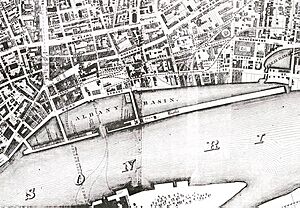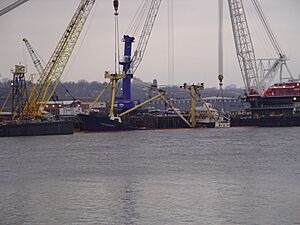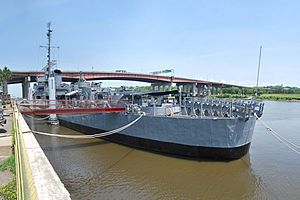Port of Albany–Rensselaer facts for kids
Quick facts for kids Port of Albany–Rensselaer |
|
|---|---|
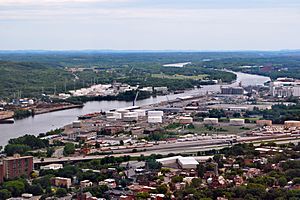 |
|
| Location | |
| Location | Hudson River Albany and Rensselaer, New York |
| Coordinates | 42°37′41″N 73°45′27″W / 42.62806°N 73.75750°W |
| Details | |
| Opened | 1932 |
| Operated by | Albany–Rensselaer Port District |
| Available berths | 18 |
| Draft depth | 38 ft. |
| Commission Chairperson | Georgette Steffens |
| Secretary | Dominic Tagliento |
| Treasurer | Joseph E. Coffey, Jr. |
| Manager | Richard Hendrick |
| Statistics | |
| Annual cargo tonnage | 7,540,535 (2004) |
The Port of Albany–Rensselaer, often called the Port of Albany, is a major shipping hub in the United States. It has facilities on both sides of the Hudson River in Albany and Rensselaer, New York. People have used these cities for shipping since the 1600s. Shipping greatly increased after the Erie Canal was built in 1825.
The port got its modern name in 1925. The current port was built in 1932 when Franklin D. Roosevelt was governor, during the Great Depression. At that time, it had the largest grain elevator in the world. Today, this grain elevator is still the largest in the United States east of the Mississippi River. The port also has the tallest harbor crane in New York State.
The port is connected to railway lines, allowing goods to move by train. It is also close to major highways and the New York State Canal System. The port even has cool tourist spots, like USS Slater. This is the only destroyer escort ship still floating in the United States!
Contents
What is the Port of Albany?
The Port of Albany covers about 236 acres (96 ha) of land. About 202 acres (82 ha) are in Albany, and 34 acres (14 ha) are in Rensselaer. It is located 124 nautical miles (230 km) north of New York Harbor. The Hudson River here is like an arm of the Atlantic Ocean, called an estuary.
The river has a deep shipping channel that is 400 feet (120 m) wide. At Albany, the river is 700 feet (210 m) across. Ships can go up to 31 feet (9.4 m) deep in the water. The water level changes by about 4.7 feet (1.4 m) with the tides. The port is at sea level.
History of the Port
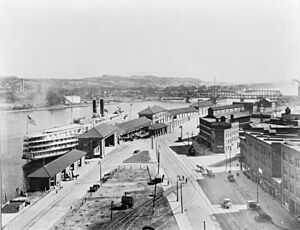
Shipping has been very important to Albany's growth since it was founded in 1614. Early on, things like furs, timber, and farm goods were sent out. European people and products were brought in. Albany became the main trading town for the upper Hudson River Valley.
For a long time, docks were built each spring and then destroyed by ice and floods in winter. In 1766, the city built three permanent docks.
Many important ships have used Albany as their home.
- In 1785, the ship Experiment sailed from Albany to China. It was only the second American ship to do so.
- In 1809, Robert Fulton's Clermont became the first successful commercial steamboat. It sailed from Albany down the Hudson River to New York City.
In 1825, a long pier was built, creating the Albany Basin. This basin was about 32 acres (13 ha) of water enclosed by the pier and two bridges. It cost about $120,000 to build. The basin was where the Erie Canal met the Hudson River. It could hold many canal boats and steamboats. Nearby, private docks were built for the lumber trade, making Albany a major lumber market.
The Albany Port District was officially created in 1925. In 1932, Governor Franklin D. Roosevelt opened a new, modern port. This new port replaced the older docks. It was built on about 200 acres (0.81 km2) in Albany and 34 acres (140,000 m2) in Rensselaer. The grain elevator built at this time was the largest in the world. As of 2008, it's still the largest in the United States east of the Mississippi River.
Today, the area of the original Albany Basin is covered by Interstate 787 and a park called the Corning Preserve.
In 2000, a plan was made to turn the port into a container port. This led to the port buying the largest harbor crane in New York State. The port also helped develop Albany's Riverfront Park. This project aimed to give people better access to the river.
In 2003, an accident happened at the port when the ship Stellamare overturned. Sadly, three crewmembers died.
The port has received awards for its customer service and for handling heavy cargo.
Future Plans for the Port
The Port of Albany is always working to improve.
- In 2008 and 2009, the port replaced 500 feet (150 m) of its docks. This cost $7.6 million.
- There was a proposal for a large ethanol plant, but it faced money issues.
- As of 2021, the port is planned to be a place where parts for offshore wind turbines can be put together.
How the Port is Managed
The Albany Port District Commission runs the port. This is a special group created by New York State. It manages port facilities in Albany and Rensselaer. The commission has five members. Four are chosen by Albany's mayor, and one by Rensselaer's mayor. The Governor of New York then officially appoints them. They work for three-year terms without pay, but their business expenses are covered.
The General Manager of the port is Richard J. Hendrick. If the port commission has money problems, both Albany and Rensselaer help cover the costs. Albany pays 88% and Rensselaer pays 12%. In 2017, the commission had 55 employees.
Port's Impact on the Economy
The Port of Albany and the businesses there bring a lot of money and jobs to the Capital District. In 2015, the port supported 4,500 jobs across the state. It added $800 million to the region's economy.
The port has a U.S. Customs office because it is a port of entry. This means goods coming from other countries can enter the U.S. here. A part of the port in Rensselaer is a "Foreign Trade Zone." This gives businesses tax breaks and other benefits.
How the Port Connects to Other Places
The Port of Albany is in a great location for sending goods around the Northeastern United States and parts of Canada.
- It's about 260 miles (420 km) east of Buffalo.
- About 225 miles (362 km) south of Montreal.
- About 175 miles (282 km) west of Boston.
- About 135 miles (217 km) north of New York City.
The port is part of the "Inland Distribution Network." This means it has regular barge service to and from the Port Authority of New York and New Jersey. Goods arriving at the port can then be sent out by truck or train. Albany International Airport is also nearby for air cargo. Canals allow goods to travel even further into North America by water.
Rail Connections
The Albany Port Railroad (APRR) has 18 miles (29 km) of tracks inside the port. It connects to major railway lines like CSX and Canadian Pacific Railway (CP Rail). This allows goods to be shipped by train from the port. Other rail yards are also close by.
Truck Connections
Major highways near the port include:
 New York State Thruway: This is a toll road that goes west to Buffalo and south to the New York City area.
New York State Thruway: This is a toll road that goes west to Buffalo and south to the New York City area. I-787: Connects Albany to Troy.
I-787: Connects Albany to Troy. I-87: Goes north to Montreal, Canada, and south to the New York City area.
I-87: Goes north to Montreal, Canada, and south to the New York City area. I-90: Goes west to Buffalo and east towards Boston.
I-90: Goes west to Buffalo and east towards Boston. I-88: Connects Albany to Binghamton.
I-88: Connects Albany to Binghamton.
Water-to-Water Connections
The Port of Albany is just south of where the New York State Canal System begins.
- The Erie Canal allows ships to travel to the Great Lakes.
- The Champlain Canal connects the Hudson River to Lake Champlain. From there, the Richelieu River and Chambly Canal lead to the St. Lawrence Seaway and Montreal.
Port Facilities and Services
The Port of Albany has many features:
- Deep water docks on both sides of the river.
- Two main docks: one in Albany is 4,200 feet (1,300 m) long with four places for ships to dock. The one in Rensselaer is 1,100 feet (340 m) long with one docking spot.
- A 20-acre (8.1 ha) open area for storing goods.
- Offices for Customs and the U.S. Department of Agriculture.
- Four large sheds and two warehouses for storage, totaling 300,000 square feet (28,000 m2).
- A grain elevator that can hold 13,500,000 US bushels (480,000,000 L; 108,000,000 US dry gal; 105,000,000 imp gal) of grain.
- Two terminals for storing 18-million-US-gallon (68,000 m3) of liquid goods.
- Special equipment for lifting very heavy items directly onto trains.
- A 12-acre (4.9 ha) depot for road salt.
- A 12-acre (4.9 ha) scrap yard.
- A large crane that can lift 225-short-ton (201-long-ton; 204-metric-ton), which is the biggest harbor crane in New York State.
Maritime Services
Companies like Federal Marine Terminals, Inc. help load and unload ships at the port. The Hudson River Pilots Association guides ships safely on the river.
Businesses at the Port
Many businesses operate at the port. In 2015, there were 23 businesses using 97% of the available space. These businesses pay rent, which helps the port earn money. Some of the companies include Cargill (the oldest tenant), Buckeye Partners, and Waste Management, Inc.
Types of Cargo Handled
The Port of Albany handles many different types of goods. Some cargo comes through regularly, while other items are special shipments for a limited time. For example, subway cars from Brazil and China have been shipped through the port. Large pipes from Italy for a natural gas pipeline also came through.
In 2015, 69 ships and barges visited the port. This was a 15% increase from 2010. Regular cargo includes:
- Animal feed
- Cement
- Cocoa beans
- Grain (like corn and wheat)
- Gypsum
- Ethanol (a type of fuel)
- Heavy items (like turbines and generators)
- Liquid fertilizer
- Scrap metal
- Molasses
- Petroleum products (like diesel, gasoline, and heating oil)
- Salt
- Steel
- Sugar
- Wood pulp and logs
Fun Things to Do at the Port
Besides shipping, the Port of Albany also has fun things for visitors. There's a ship museum and a cruise ship for tours. Steamboat Square is where these attractions are located.
- The USS Slater is a museum ship docked at Steamboat Square. It's the only destroyer escort ship still floating in the United States! You can visit the ship from April to November. During winter, it moves to the Rensselaer side of the port.
- Dutch Apple Cruises offers boat tours on the Hudson River and Erie Canal.
- The city of Albany has a public boat launch and boat house in the Corning Preserve. A non-profit group called Albany Rowing Center uses these facilities for rowing.
- On the Rensselaer side of the river, you'll find the Albany Yacht Club. It was founded in 1873 and is one of the oldest yacht clubs in the country. Its facilities are open to everyone, not just members.



